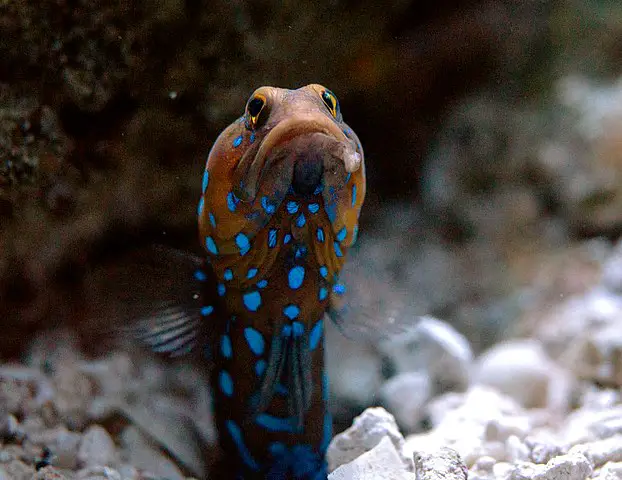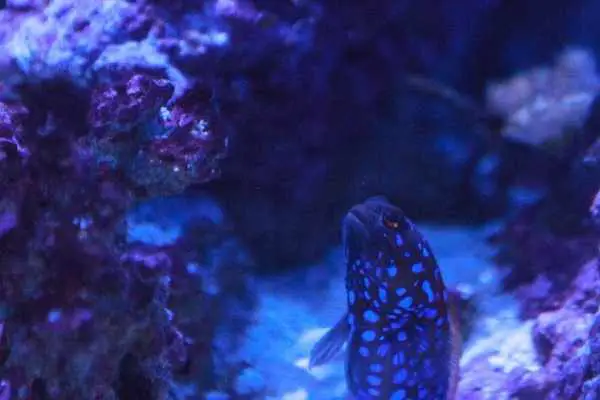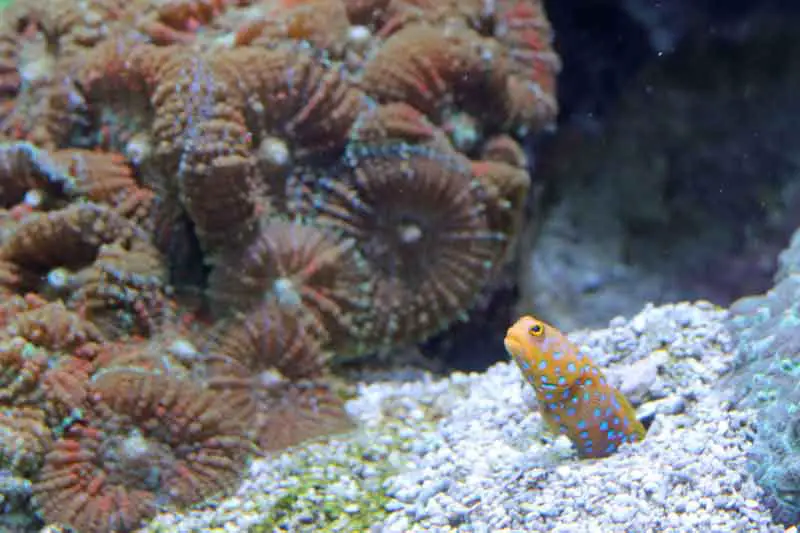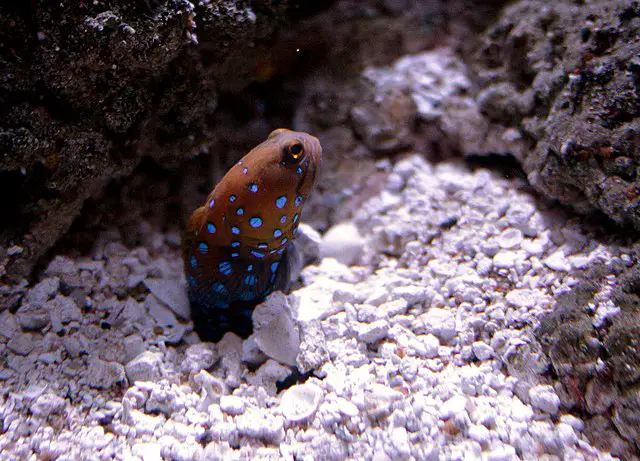Blue-Spotted Jawfish (Opistognathus rosenblatti) are curious members of the jawfish community. Their unique coloration makes them appealing to aquarists, as does the jawfish burrowing behavior. However, these vibrant little fish aren’t for just anyone. If you’re not prepared to handle their particular care needs, they may need to remain a “pipe dream.”
Table of Contents: Blue-Spotted Jawfish Care
Are you interested in one element of jawfish management? The following links will guide you through everything you need to know about blue-spotted jawfish care. If you’re determined to bring one home, you can read the entire article and learn everything there is to know about these cold-water burrowers.
- Quick Facts
- Description of the Blue-Spotted Jawfish
- Blue-Spotted Jawfish Lifespan
- Creating the Ideal Jawfish World
- Blue-Spotted Jawfish Diet
- Blue-Spotted Jawfish Behavior and Tank Mates
- Breeding the Blue-Spotted Jawfish
- Pros and Cons
- For More Information
Quick Facts
- Common Names: Blue-jaw, Rosenblatt’s jawfish, Blue dot jawfish
- Scientific Name: Opistognathus rosenblatti
- Size: 4-6 inches (10.1-15.2cm)
- Minimum Tank Size: 30 Gallons (113.5L)
- Reef Safe? Yes
- Care or Experience Level: Moderate
- Preferred Diet: Carnivore
- Original Part of the World: Sea of Cortez

Description of the Blue-Spotted Jawfish
Jawfish, as a group, have a standard broad head tapering down into a thinner body. They have powerful jaws (imagine that) adapted into “scoops” to shift sand, coral, shells, rocks, and other debris along the substrate to form their burrows.
Blue-spotted jawfish break with that tradition a little. Their dens extend straight down, rather than taking a more diagonal pathway. The burrows can reach anywhere from 4-9 inches (10.1-22.8cm) deep, 9 inches (22.8cm) wide, and a minuscule 2.5 inches (6.4cm) in height. They outline the den with pieces of coral, mollusk shells, and other materials they gather along the sandy bottom.
You can easily pick out a blue-spotted by the vivid blue spots covering an otherwise unremarkable body. Even females and juveniles have bright blue spots. Perhaps it doesn’t make their name unique, but it means you know when you’ve stumbled across one. A youngster will have more of a yellow background, and females have larger spots than males. During spawning displays, the front half of a male will turn white, the back half black. But you’ll always, always see those spots.
Blue-Spotted Jawfish Lifespan
Blue-spotted jawfish set up patrols roughly five feet (1.5m) above their burrows in the wild. This gives them an unobstructed view. If there are obstacles in the way, they may only lift their heads out of the den entrance to preserve a sense of safety. It keeps them alive and healthy for between 3-5 years. And that stays about the same in captivity.

Creating the Ideal Jawfish World
Blue-spotteds hang out at depths between 10-150 feet off the coast of Baja Mexico. Due to their need to burrow, they prefer sandy regions to rocky. And those areas run smack dab through the middle of the California Current. So while the Sea of Cortez IS a tropical region, the waters get their temperature from Alaska’s chilly depths. This means if you plan to bring home a blue-spotted jawfish, you’re going to need a chiller.
Many novice aquarists focus on the vibrant colors, and the warm beaches Baja is known for. Then they settle a blue-spotted into a tropical saltwater aquarium. Before they know it, they have a jawfish that’s succumbed to heat exhaustion. Cooler temperatures are the order of the day. And while the ambient temperature in your house may seem sufficient, a chiller is the best way to make sure your jawfish stays healthy.
You also need to invest in a quality lid. Jawfish have no problem heaving themselves OUT of the tank! If they feel uncomfortable in any way, they’ll begin swimming along the sides and especially into the corners, looking for an escape. Without a sturdy cover, you could discover a flopping jawfish on the floor (or worse, a NON-flopping jawfish).

They need a burrow to feel safe and secure. This means you’ll need to provide plenty of sand and “rubble” for the excavation process. You want a minimum of 8 inches (20.3cm) of mixed sands. You should also add in broken coral (please don’t harm YOUR coral), pebbles, and mollusk shells.
You’ll see these materials start to dwindle as your jawfish goes through construction. Keep adding more until the substrate looks natural again. Most blue-spotted jawfish like to adorn the opening of their burrow with a shell. They’ll set it aside in the mornings, closing things up in the evenings. (It’s always important to “lock” your home at night)
Unfortunately, the need for those excavations means you can end up with disgusting sand. A deep sandy bottom (which you’re going for) can build up toxic air bubbles. You’ll want a powerful filtration system to prevent ammonia and nitrates from getting too high. You can also add sand-sifters, such as bristle worms or Nassarius snails, to help keep things moving.
Blue-Spotted Jawfish Tank Size
Blue-spotted jawfish aren’t particularly large fish. Their dens, though? That’s an entirely different matter. You need to leave enough room for a healthy burrow. This comes out to a minimum tank size of 30 gallons (113.5L) for ONE jawfish. If you want to consider keeping a pair (or more), you need to break out the calculator and Geometry book.
Why? Blue-spotteds don’t share their hard work. Each glorious burrow holds ONE jawfish, and no more. So that means you need to allow for 3 feet (0.9m) between EACH jawfish den. You also have to make sure you have 2 feet (0.6m) between the den and the sides of the aquarium. So when you start trying to get more than a single jawfish, the size of the marine tank gets pretty considerable. It’s not impossible, but it can get tricky to manage. Double-check all of those calculations carefully.

Are Blue-Spotted Jawfish Reef-Safe?
Jawfish have no problem sharing space with corals. They use broken coral branches in their burrows, but they don’t actively go after the corals. The pieces they carry around are those they find lying in the sand. Sometimes, it may even be a fragment they’ve stolen from a neighbor’s building supplies (less work, right?). You can set them up in your reef tank without a worry.
Blue-Spotted Jawfish Diet
Blue-spotted jawfish are zooplanktivores. This means they feed on the microscopic animals swimming in the water column. They snatch them up either when they’re drifting over their den or peeking out of the burrow “door.” It may sound like that would make them difficult for an aquarist to feed, but if you take a few simple steps, you’ll find your little jawfish happily snacking away.
First, a refugium is your best friend. Flip the photoperiod, so it’s opposite that of your saltwater aquarium. This way, the little nocturnal creatures will go directly into the primary tank, offering a regular menu for your blue-spotteds to feed on. Jawfish appreciate a dimmer lighting scheme, despite their shallow-water existence, but they’ll tolerate any set-up you may offer. (So long as you don’t turn the lights on out of nowhere)
If you don’t have a refugium, you can add foods to the pump discharge several times throughout the day. The following work well as potential options for your jawfish:
- Enriched brine shrimp
- Formula 1
- Mysis shrimp
- Plankton
Some blue-spotted jawfish come fresh from the ocean. They’re picky and won’t accept anything less than the real deal. You’ll need to invest in live brine shrimp or blackworms to get that feeding drive going. You can TRY grating de-shelled shrimp into the tank. It’ll resemble copepods which may trick your blue-spotted jawfish. If you’ve exhausted other options, it’s worth a try.
Blue-Spotted Jawfish Behavior and Tank Mates
Despite their personal space needs, blue-spotted jawfish are quite social. In the Sea of Cortez, you’ll find them spaced out over open sandy areas. They have no problem living alongside one another – as long as everyone stays on their side. If you want to see your jawfish, though, you’re better off sticking to one. (Sad, but true, unfortunately) They’ll end up the most out-going and active that way. Otherwise, they’ll probably bob their heads in and out of the den (you see in this video). If you want a fishy prairie dog kingdom, you’ll end up set.
When you want to integrate them with OTHER fish, things get a little trickier. Jawfish are particular. They don’t like change. As such, you need to add them to your marine tank FIRST. This gives them a chance to set up their den, adjust to the tank, eat, and settle in. It’s not impossible to add a blue-spotted jawfish to an established aquarium, but there may be more stress involved if other fish are already present. And if you want to keep that stress as low as possible, you need to choose SLOW, peaceful tank mates. If there’s dramatic activity – especially at feeding time – your jawfish will huddle in the burrow out of fear.
Some of the best tank mates for blue-spotted jawfish include:
- Assessors
- Blennies
- Cardinalfish
- Dragonettes
- Gobies
- Pipefish
It’s tempting to add speed into your reef tank, especially since jawfish…well, they just kind of hang there. But hyperactivity can send the poor jawfish scrambling for their den. If they hide away and refuse to eat, they’ll pass away. And if they die within their burrow, you’ll have a tremendous release of ammonia into the sand (unless you notice their absence before then). So skip angelfish, butterflyfish, and surgeonfish. They simply have too much swimming power.
Breeding the Blue-Spotted Jawfish
Unless they’re performing their spawning courtship, you may not notice the difference between male and female blue-spotted jawfish. True, females have larger spots, but it’s not the easiest trait to pick out unless you compare two side-by-side. It’s only during the spawning season – which occurs during the spring and summer – that you’ll see the sexual dichromatism (i.e., different color patterns).
Most mating rituals coincide with the crepuscular period of dawn or dusk during the new or full moon. A male jawfish will swim about 3-4 feet (0.9-1.2m) above his den and dance. Combined with the color change, the performance attracts a female. She either follows him into his burrow OR a den explicitly built for the spawning process. She lays between 300-500 eggs and leaves. The male then fertilizes the eggs before collecting them. That’s right – jawfish are mouthbrooders!
The male incubates the eggs for a little over a week. The fry then escape. At that point, the male’s free to repeat his spawning ritual with a new female. The fry start to dig their dens when they’re 15-days-old (approximately 0.5 inch/1.5cm long). They’ll reach adult size within a year.
Blue-spotted jawfish WILL breed in captivity. You just need to make sure you have that crucial tank size to support the pair. You also want middle-aged fish. Once jawfish pass that mid-point, they stop responding to the mating ritual. They’ll continue to finish out their natural lifespan, but you won’t have a chance for any more blue-spotted fry.
Pros and Cons
Blue-spotted jawfish have a stunning appearance. And the jawfish burrowing behavior is fun to watch and participate in (even if you won’t see 99% of the den). But these little fish aren’t the easiest to care for. If you’re considering one, make sure you consider both sides of the coin:
Pros
- Blue-spotted jawfish are often one of the last fish in a saltwater aquarium to fall ill. This is despite the fact that they have tiny scales. They don’t usually succumb to parasites or other infections easily.
- While jawfish often use coral branches and other pieces in their burrows, they’re 100% reef-safe. Those decorations get scavenged from the substrate.
- Despite being zooplanktivores, you can easily make adaptations to the diet to keep your jawfish happily fed.
Cons
- Blue-spotted jawfish require deep sand beds, which require powerful filtration or live assistance to prevent toxic air bubbles.
- While highly social, you need to provide appropriate space to keep more than one jawfish in a single aquarium.
- The species is native to the Sea of Cortez, which is COLD, necessitating a chiller for the aquarium to reach the appropriate temperatures.
For More Information
Blue-spotted jawfish are curious-looking fish that encourage people to pause outside the tank. Whether it’s those vivid spots or the den-building behavior, there’s just something that catches interest. This is why you know you need more information!
This YouTube video shows a blue-spotted jawfish hard at work, clearing out a burrow. This is often part of a daily routine.
Want to learn more about the best jawfish tank mates?
- Marine Betta
- Lawnmower Blenny
- Midas Blenny
- Tailspot Blenny
- Banggai Cardinalfish
- Pajama Cardinalfish
- Diamond Goby
- Engineer Goby
- Neon Goby
- Firefish Goby
- Mandarin Goby
- Pipefish
You want to get your jawfish set up on the right fins. That means researching the best tank materials:
Blue-spotted jawfish ARE hardy. However, they often succumb to this nasty disease:
Conclusions
Blue-spotted jawfish probably don’t have the most original name on the planet (no one said scientists were creative). However, they have a stunning appearance that catches the eye immediately. They also exhibit a burrowing behavior that makes them fun to watch, even if they’re just doing a little maintenance. If you’re ready to tackle their particular tank needs (don’t forget that chiller!), they’re the perfect little fish to add to your reef tank.
Maybe you can even get one to “spy hop” with you!
References
- Bussing, W.A. and Lavenberg, R.J. 2003. “Four New Species of Eastern Tropical Pacific Jawfishes (Opistognathus: Opistognathidae). International Journal of Tropical Biology and Conservation. 51: 529-550.
- Fenner, B. 2012. “A Cool Fish in More Than One Sense: The Blue-Spotted Jawfish Opistognathus rosenblatti.” Tropical Fish Hobbyist.
- Lieske, E. and Myers, R. 1996. Coral Reef Fishes.
- Michael, S.W. 2000. “The Whimsical Jawfishes.” Aquarium Fish Monthly. 12:8.
- Thomson, D.A., Findley L.T., and Kerstitch, A.N. 2000. Reef Fishes of the Sea of Cortez.


Leave a Reply